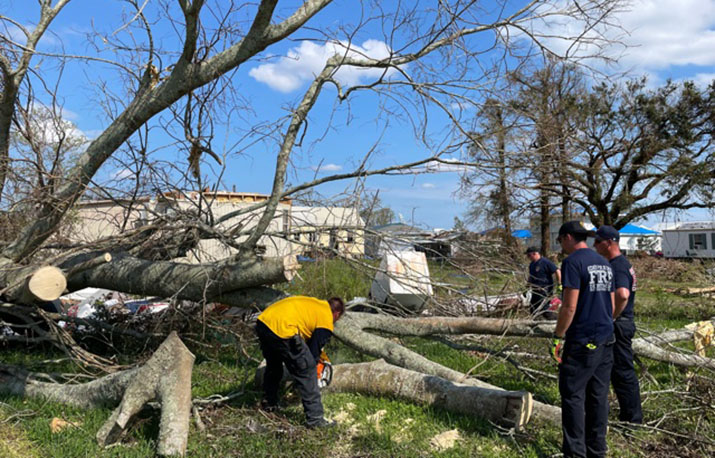Helping the helpers in Louisiana
Sept. 16, 2021

When any disaster – even a Category 4 Atlantic hurricane – strikes, first responders do what they do best: They drop everything and help. But their resources, energy and even health aren't bottomless. Even the helpers need help sometimes. That's when they use the
Emergency Management Assistance Compact (EMAC).
After Hurricane Ida made landfall, Louisiana put out EMAC requests for help, and 21 states answered the call. Minnesota was one of them, offering
22 firefighters from nine departments across the state. When they arrived in Louisiana on Sept. 9, many of the local firefighters had been on duty since the storm struck on Aug. 26. Fifteen days without rest. Fifteen days without a chance to tend to their own damaged properties, their own frightened families.
After sending their Louisiana counterparts home to rest, the Minnesota firefighters got to work. They set up their base of operations at Nicholls State University in Thibodaux, about 60 miles west of New Orleans. They share a “tent farm" – a collection of 22-person tents with air conditioning, lights and outlets – with other firefighters, police, EMS and National Guard from around the nation. They got to work immediately, clearing debris on campus and later joining four Massachusetts firefighters in restoring a hurricane-damaged veterans' memorial to its proper glory in a town called Cut Off.
 Some of the Minnesota firefighters were then sent in four-person teams to cover fire stations in the areas of Chackbay and Springfield. Both of those crews have been heavily involved in removing debris left over from Ida, as well as checking on citizens and distributing necessities like tarps and bottled water. But they're also doing what firefighters usually do: responding to medical and carbon monoxide calls, putting out rubbish fires, and dealing with arcing wires and vehicle crashes. Each four-person Minnesota crew will be replaced by their counterparts from the base of operations every 48 hours, although that could change if they're asked to cover more fire stations. The base of operations itself has had to pause in their work as Hurricane Nicholas dumps rain on Thibodaux and the surrounding area this week.
Some of the Minnesota firefighters were then sent in four-person teams to cover fire stations in the areas of Chackbay and Springfield. Both of those crews have been heavily involved in removing debris left over from Ida, as well as checking on citizens and distributing necessities like tarps and bottled water. But they're also doing what firefighters usually do: responding to medical and carbon monoxide calls, putting out rubbish fires, and dealing with arcing wires and vehicle crashes. Each four-person Minnesota crew will be replaced by their counterparts from the base of operations every 48 hours, although that could change if they're asked to cover more fire stations. The base of operations itself has had to pause in their work as Hurricane Nicholas dumps rain on Thibodaux and the surrounding area this week.
The Minnesota firefighters hail from Eden Prairie, Plymouth, the West Metro Fire District, the Centennial Fire District, the Spring Lake Park Blaine Mounds View (SBM) Fire District, Red Wing, Chaska, Brainerd and Crosslake fire departments. Many of them are taking time off from their own jobs to help with the hurricane recovery in Louisiana, leaving their families and the familiar Minnesota terrain to venture into unknown territory and unknown dangers. Their mission is scheduled to last 18 days, including travel time to and from Louisiana.
EMAC is a mutual aid agreement among all 50 states. A requesting state can ask for resources such as people and equipment based on their needs, and any state can respond – although no one is obligated to participate. The requesting state covers the cost, and in Minnesota, the Department of Public Safety Homeland Security and Emergency Management division (DPS-HSEM)
coordinates the EMAC requests.
Even heroic humans don't have an infinite amount of energy. And sometimes natural disasters require first responders and emergency managers to ask for help. So it's good to know that there are others out there who are willing to travel over a thousand miles to continue their good work while they rest to fight another day.

